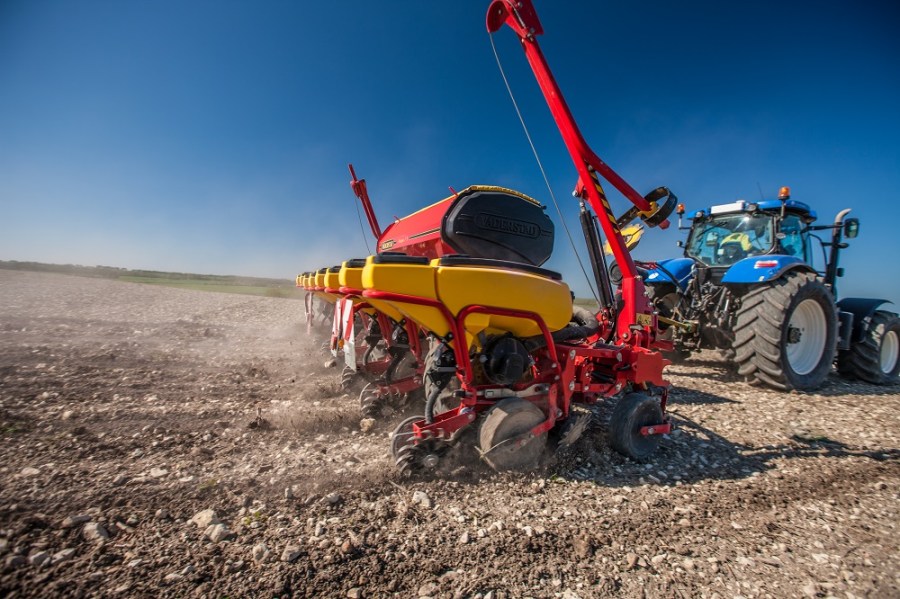Speed, accurate singling and precision placement are what today’s operators look for in a maize drill. CPM looks at some recent developments.
Having a drill that achieves accurate placement and seed depth is important.
By Jane Brooks
A fundamental feature of maize is that the day you drill is the day you set the life cycle of the crop in motion. Control methods are more limited after drilling, because maize is a crop where there are no growth regulators.
That’s the view of John Burgess, maize specialist at KWS UK, who emphasises the importance of achieving the right seed depth in all soil types.
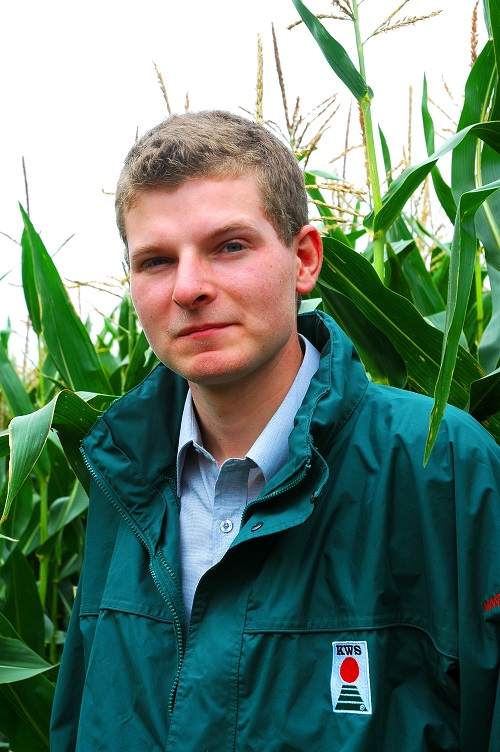
Accuracy of drilling depth is key, says John Burgess, and there’s a direct trade between drilling depth and forward speed.
“Accuracy of drilling depth is key, there’s a direct trade between drilling depth and forward speed. Drilling too rapidly can lead to shallow placement. Then, certainly on sandy soil, the root zone isn’t deep enough and can lead to drought problems.”
He recommends measuring the soil temperature at 10cm depth, aiming for a minimum at planting of 8°C. “Heavier soil warms up more slowly,” he notes. “Having a drill that achieves accurate placement and seed depth, particularly when you have a lot of clods on the surface, is important.”
The base mark seed rate is around 100,000 seeds/ha (10/m²). “Different drills give different row spacings and placement, but these numbers don’t really change.
“Maize can be drilled from mid April to the first week of June. Late drilling loses days of growth, so reduce the plant population incrementally – more space gives plants more light, allowing crops to claw back any lost maturity.”
But lowering seed rates requires higher drilling accuracy as the drill operates to a minimum level of plants per m². “The accuracy of seed placement, the degree of misses or doubles in a row are therefore critical. If you’re reducing seed rate but still getting doubles, it’s a real issue as you’ve less plants to compensate for the effect. It’s all down to the accuracy of the drill,” points out John Burgess.
Double-row planting
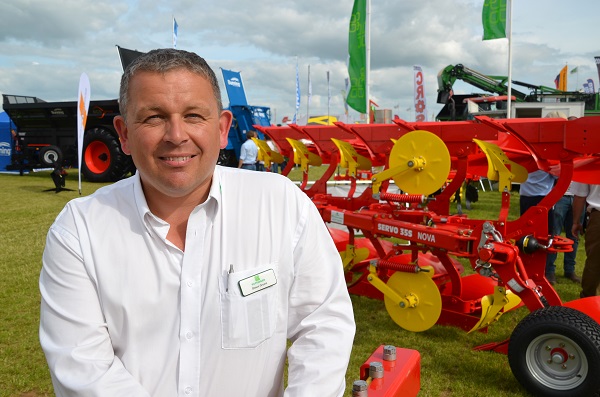
Duplex seeding offers the potential to achieve greater yield returns than conventional single-row plantings, says Shaun Groom.
Pöttinger’s new Duplex Seed system plants maize for silage or grain harvesting in double rows. It’s available on Aerosem Precision Combi Seeding (PCS) mounted seed drills.
The system drills double rows of offset plants spaced at 12.5cm, with a gap of 75cm between rows. It’s easy to convert the drill between different seed types and the double rows of maize can be harvested using standard headers.
Using the system, maize can be planted with a companion crop or with direct fertilisation. As well as up to a 10% better yield, Pöttinger says higher driving speeds of up to10km/h can be achieved.
To change from drilling cereals to maize planting, simply fold over the hopper partitions, fit the firming rollers and slot formers. Seed quantity is changed at the operator terminal by tapping in the number of seeds per ha or m² – there’s no need to adjust the drive chain. Each row of maize is monitored directly at the coulter and centrally using the level indicator at both ends of the maize hopper.
Double-row planting puts 30% more space between the seeds and 70% more available for each plant, says Shaun Groom of Pöttinger UK, which means the roots spread unhindered in the soil.
“A strip of fertiliser delivered to the side encourages outward root growth, and the maize crop absorbs more sunlight because the plants don’t shade each other as much as in a conventional formation. Double-row single-pass drilling also provides improved erosion protection because it doesn’t leave additional wheel marks.”
The Duplex seed system delivers around a 25% increase in planting performance, he claims, due to the higher driving speed of up to 10 km/h. A four double-row drill with a working width of 3m has an output of almost 2ha/h.
“The initial results shown by Duplex seeding offer potential to achieve greater fresh-weight yield returns than conventional single row plantings over the same area,” says Shaun Groom.
“The Pottinger Aerosem seed drill equipped with PCS Duplex technology is also more flexible than a single-purpose precision seed drill as you can use it throughout the year.”
The Väderstad Tempo range is built for speed and offers precision planting with seeding rates of up to 28 seeds/sec. At the heart of the Tempo lies the PowerShoot system, which uses pressure to precisely control the seed transport. When leaving the short seed tube, a soft press wheel stops the seed and ensures optimal seed-to-soil contact.
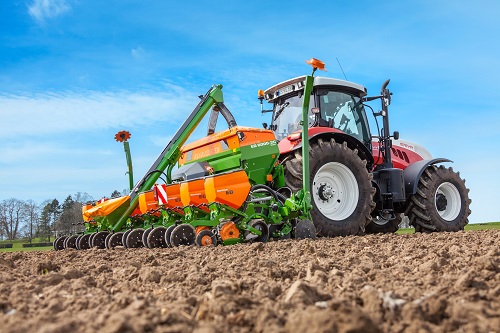
The Amazone ED range is available in 3m and 4.5m rigid or 4.5m and 6m folding versions.
Key to the system is the electrically driven Gilstring Seed Meter, which delivers singulation and precision at high driving speeds, irrespective of slopes or vibrations. Each seed meter has an electric motor, enabling individual row shut off, easy calibration and in-cab seed rate adjustments.
The mounted Tempo T is a high-speed precision planter with telescopic wing retraction. It’s available in six-row and seven-row configurations with different row spacings between 50-80cm. The machine has a transport width of 3.36-3.5m.
Väderstad has brought its controls into what it calls its E-Services platform. You can opt for ControlStation, ISOBUS, E-Control, and a combination of the latter two.
All sensors and valves on Väderstad drills connect to a WorkStation. Drills controlled by ISOBUS or E-Control are also equipped with a Gateway which communicates with an iPad-air or an ISOBUS terminal in the tractor cab. To log statistics together with actual position, the Gateway is equipped with a GPS receiver.
The Tempo T with combi, which includes fertiliser placement while planting, was introduced in 2014. For planting maize, a seed plate with 32 holes and a diameter of 5.5mm is standard, other seed plates are available.
Last year, the FH 2200 front-linkage mounted fertiliser hopper was introduced. Developed to handle fertiliser volumes of up to 250kg/ha at a speed of 15km/h the 2200-litre hopper is equipped with an electric Fenix III metering system.
The distributor head on the planter can be factory fitted on Tempo V and Tempo R, or ordered as an adjustable mounting kit for other planter models.
When the FH 2200 is operated with a Tempo, it connects to the Gateway on the planter. Both operate with the iPad-based control system Väderstad E-Control or the ISOBUS-terminal of the tractor. The FH 2200 can be operated via a ControlStation and separate ground radar.
Amazone offers the ED and EDX precision air-seeder range. ISOBUS communication is available on the ED, enabling it to operate with Amazone Amatron 3, CCI 100 and Amapad, or other ISOBUS-compatible terminals.
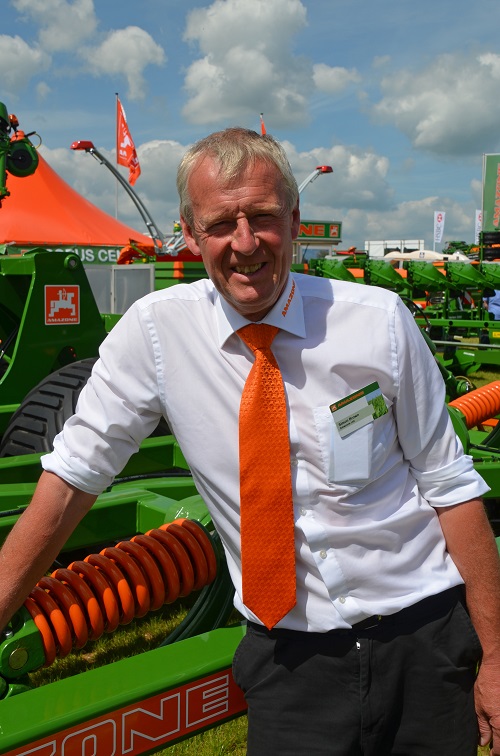
The ED and EDX coulter systems provide good seed-to-soil contact and that helps keep the seed spacing at the optimum, says Simon Brown.
Amazone ISOBUS machinery is supplied ready for use with Task Controller, the company’s integrated data-recording and job management package, while variable rate application, section control and other functions can be used with an appropriate terminal. Functions such as electric half-side shut-off, increasing or decreasing seed rate or stopping the metering unit can be operated through the ISOBUS-compatible AUX-N joystick and AmaPilot+.
The ED range is available in 3m and 4.5m rigid or 4.5m and 6m folding versions. All models can be supplied with a FRU 104 front tank of up to 2000 litres capacity. The ED Special has a mechanical chain-drive gearbox. On the ED Super, hydraulic drive to the singling units and an electrically driven fertiliser metering system are controlled from the cab.
The ED Super’s individual seeding units can be controlled automatically via GPS. Seed press rollers with easy pressure adjustment are also available. New wheel-track eradicators, three coulter options for different soil types and new press roller options completed the line-up.
Sowing units are each equipped with 60-litre seed hoppers. The Classic and Contour units suit maize, oilseed rape, beet, sunflowers, beans and peas. The Classic will follow ploughing, whereas the Contour is ideal for min-till. Minimum row spacing of 30cm allows up to 10 rows on a 3m working width.
Two trailed EDX models are available in the UK: the EDX 6000-TC has a seasonal output of up to 1500ha, while the EDX 9000-TC output is around 900ha. Twin wheels to straddle a 75cm-wide maize row are available.
“The ED and EDX coulter systems provide good seed-to-soil contact and that helps keep the seed spacing at the optimum,” says Simon Brown of Amazone. “Above all, it produces an excellent even start to the seedling’s development. This quick germination is then aided by the nutrient boost provided by the deeper placed fertiliser to enhance root growth.
“On the EDX, the centralised hopper system, with in-cab control over rate and singling adjustment, makes using the drill comfortable and accurate. GPS section control on both models reduces seed wastage and over-population on the headlands.”
Gaspardo’s Maga 8-row precision drill is an ideal choice for contractors who drill forage and biogas maize as its design includes variable row-width settings, says James Woolway of Opico, sole UK importers for the drill.
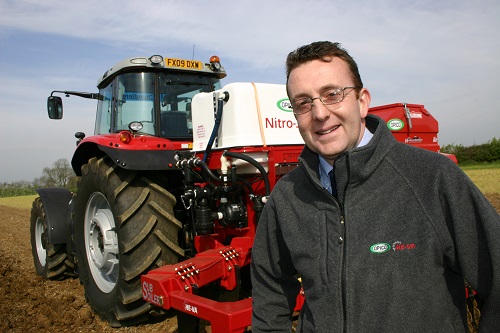
if maize plants are too close together the number of cobs reduces, changing silage composition, explains James Woolway.
“There’s a balance between plant density and number of cobs – if plants are too close together the number of cobs reduces, changing silage composition,” he explains.
“When planting forage maize, research has shown 75cm to be the optimum row width for dry matter yield and feed value. With AD maize, cob numbers are less important than the amount of DM yield, so AD maize growers tend to bring row spacings down to around 50cm.
“The Maga can be quickly altered from 45-75cm row spacing, allowing contractors to meet the demands of all types of customer.”
The Maga MTR planting unit gives precision planting at greater speeds, allowing higher outputs, he says. The seeding unit has a Double Disc furrow opener, with opening discs of 420mm diameter.
The Armstrong cast steel parallelogram linkage is 30% stronger than a traditional linkage, adds James Woolway, and with the opening disc gives high-speed stability and a constant seeding depth.
Suitable for min-till, the Maga closes to 3m for road transport. Other features include: Muller Precimat control box; double drive transmission; 36-litre seed hopper, 900-litre stainless steel fertilizer hopper for big bag fertilisers and optional 30-litre microgranule applicator.
Kuhn’s Maxima 2 pneumatic precision seed drills offer various row spacing and frame configurations based around the Maxima seeding unit. There are rigid or folding models, going from 4-18 rows in fixed or variable-width options.
Fully ISOBUS-compatible, they offer row-by-row section control. Fertiliser placement fed from front and rear hopper options and granular-applicator options are available.
Kuhn says the three most popular models are the 8-row folding RT, the 12-row RXL contractor model and the telescopically adjustable variable row width T IM.
The Kuhn Maxima 2 T IM is a 7-row pneumatic seed drill with in-cab hydraulic spacing adjustment. It provides inter-row spacing of 50-55-60-65 using 7 rows and 70-75-80 with 6 rows.
The transition from 7 to 6 rows takes 15 mins, claims Kuhn, and the drive wheels automatically position between rows, whatever the seeding unit spacing. The company says the Maxima 2 T IM 3.5-4.8m models work at speeds of 6-10 km/h, covering 2-4ha/h. It’s also possible to seed with different spacings to establish tramlines, for example.
The Maxima seeding unit has 120kg minimum ground pressure, producing constant depth seeding, while the large diameter disc provides uniform high-speed seeding. Depending on the model, the polyethylene hoppers have capacities of 2x 260 litres, 950 litres and 1350 litres.
The pneumatic micro-granular distributor spreads insecticides, slug pellets, weed killer or micro starter. The KMS208 and KMS412 control boxes monitor seeding and the KMD112 disengagement box shuts off rows, manually or automatically.
Kuhn’s Maxima 2 range of drills also suit strip tillage systems and will drill crops including maize, sugar beet and OSR.
AD maize area grows
The National Non Food Crop Centre 2016 Report on Anaerobic Digestion deployment in the UK identified 316 operational AD plants in the UK. This Includes 47 biomethane-to-grid plants, while there are 454 AD projects under development.
Using June 2104 census information, Defra estimated the area of maize grown in England at 171,000ha, of which 29,000ha was for AD use. By 2016 the area of maize grown for AD was 52,280ha. This is 29% of the total area of maize grown in England and 1% of the country’s total available arable area.

